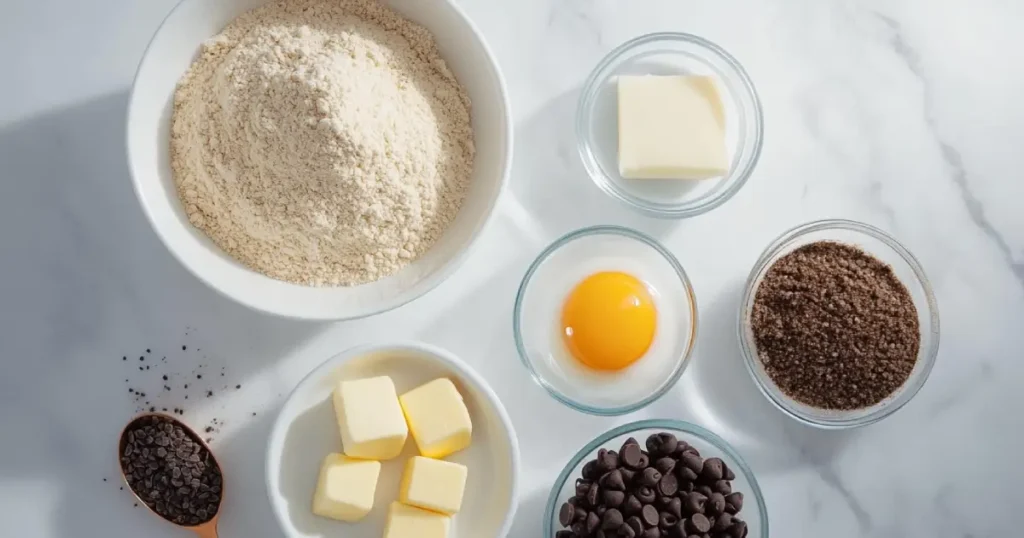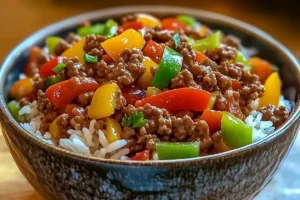If you’re looking for a delicious, gluten-free treat that’s rich, chewy, and packed with chocolatey goodness, almond flour chocolate cookies are the perfect choice. Made with simple, wholesome ingredients, these cookies are naturally grain-free, low in carbs, and full of flavor. Whether you’re following a gluten-free diet, looking for a healthier dessert option, or just love trying new cookie recipes, this guide has everything you need to bake the best almond flour chocolate cookies.
In this article, we’ll explore why almond flour is a great alternative to traditional wheat flour, the key ingredients that make these cookies irresistible, and a step-by-step guide to ensuring perfect results every time. We’ll also cover tips for texture, storage solutions, and variations to suit different dietary needs, including keto and vegan-friendly options.
Outline
Why Use Almond Flour for Cookies?
Almond flour is a game-changer in gluten-free and low-carb baking. It not only provides a deliciously nutty flavor but also offers a soft and chewy texture that’s perfect for cookies. Unlike traditional wheat flour, almond flour is naturally grain-free and packed with nutrients. In this section, we’ll explore the health benefits of almond flour and how it affects the texture of your cookies.
Health Benefits of Almond Flour
Almond flour isn’t just a substitute for regular flour—it’s a powerhouse of nutrition. Here’s why it’s a great choice for baking cookies:
- Naturally Gluten-Free & Grain-Free – Ideal for those with celiac disease or gluten sensitivity.
- Rich in Healthy Fats – Supports heart health with monounsaturated fats.
- High in Protein & Fiber – Helps keep you full longer and stabilizes blood sugar levels.
- Low in Carbohydrates – A great alternative for keto and low-carb diets.
- Packed with Vitamin E & Antioxidants – Supports skin health and helps fight inflammation.
By using almond flour, you’re not just making your cookies healthier but also adding essential nutrients to your diet.
How Almond Flour Affects Cookie Texture
If you’ve never baked with almond flour before, you might be wondering how it changes the texture of cookies. Here’s what makes it special:
- Soft and Chewy Consistency – Almond flour holds moisture well, resulting in soft and tender cookies.
- Slightly Nutty, Buttery Flavor – Enhances the overall taste without overpowering the chocolate.
- More Moisture Retention – Prevents cookies from becoming dry or crumbly.
- Less Structure Than Wheat Flour – Cookies may spread more, but this can be controlled with proper ingredient balance.
Unlike wheat flour, almond flour doesn’t contain gluten, which acts as a binder in traditional baking. This means your cookies may be a little more delicate, but with the right recipe, you’ll get the perfect chewy texture.
Enjoy the crisp and chocolaty goodness of these Chocolate Wafer Cookies with this simple recipe from Buttery Recipes!
Essential Ingredients for Almond Flour Chocolate Cookies

The secret to making perfect almond flour chocolate cookies lies in choosing the right ingredients. Each component plays a crucial role in achieving the ideal texture, flavor, and structure. Below, we’ll break down the key ingredients and how they impact your cookies.
Almond Flour: The Star Ingredient
Since almond flour is the base of this recipe, using the right type makes a big difference.
- Blanched Almond Flour – Made from almonds with the skins removed, this flour is finely ground, creating a smoother texture in cookies.
- Almond Meal – Coarser in texture, made from whole almonds (skins included). It works, but cookies may be grainier and denser.
Pro Tip: Always use blanched almond flour for the best cookie texture. Store it in an airtight container in a cool, dry place or refrigerate to extend shelf life.
Sweeteners: Choosing the Right One
The choice of sweetener affects both the taste and texture of your cookies. Here are some options:
- Coconut Sugar – A natural alternative to white sugar with a mild caramel-like flavor.
- Maple Syrup or Honey – Adds moisture and natural sweetness but can make cookies softer.
- Brown Sugar – Creates a richer, chewier texture.
- Monk Fruit or Erythritol – Great for keto and low-carb options, but may slightly alter the texture.
Pro Tip: If using liquid sweeteners (maple syrup or honey), reduce other wet ingredients slightly to prevent overly soft cookies.
Fats and Binding Agents
Fat is essential for moisture, flavor, and structure. Here’s what works best:
- Butter – Adds richness and enhances the flavor.
- Coconut Oil – A dairy-free alternative that keeps cookies soft and chewy.
- Ghee – Provides a slightly nutty taste and works well for paleo baking.
Egg Substitutes for Vegan Cookies
If you want to make these cookies egg-free, try these replacements:
- Flax Egg (1 tbsp ground flaxseed + 3 tbsp water) – Helps bind the ingredients.
- Applesauce (¼ cup per egg) – Adds moisture but may make cookies softer.
- Mashed Banana (¼ cup per egg) – Works well but will slightly change the flavor.
Chocolate Choices: What Works Best?
Chocolate is the highlight of these cookies! Here’s what to consider:
- Dark Chocolate (70% or higher) – Rich and intense flavor with less sugar.
- Milk Chocolate – Sweeter and creamier, perfect if you prefer a milder taste.
- Sugar-Free Chocolate – Ideal for keto-friendly cookies.
- Chocolate Chunks vs. Chips – Chunks melt better and create gooey pockets, while chips hold their shape.
Pro Tip: Use high-quality chocolate for the best flavor. Chop a chocolate bar into chunks for an extra indulgent texture.
Other Flavor Enhancers
- Vanilla Extract – Adds depth and enhances the chocolate flavor.
- Sea Salt – A small pinch brings out the sweetness and balances flavors.
- Cinnamon or Espresso Powder (Optional) – A touch of either can intensify the chocolatey taste.
Now that we’ve covered the essential ingredients, it’s time to dive into the step-by-step process of making the perfect almond flour chocolate cookies. Let’s get baking!
Step-by-Step Guide to Making Almond Flour Chocolate Cookies
Now that we have all the essential ingredients, it’s time to bake! Follow this step-by-step guide to ensure your almond flour chocolate cookies turn out soft, chewy, and full of chocolatey goodness.
Step 1: Gather Your Ingredients
Before you start mixing, measure out all your ingredients. Having everything prepared in advance makes the process smoother. Here’s what you’ll need:
- 2 cups blanched almond flour
- ½ cup coconut sugar (or sweetener of choice)
- ¼ teaspoon sea salt
- ½ teaspoon baking soda
- ½ teaspoon vanilla extract
- 1 egg (or flax egg for vegan option)
- ¼ cup melted butter or coconut oil
- ½ cup chocolate chips or chunks
Pro Tip: Let ingredients like eggs and butter come to room temperature before mixing. This helps create a smoother dough.
Step 2: Mixing the Dough
- Combine Dry Ingredients
- In a medium bowl, whisk together the almond flour, coconut sugar, sea salt, and baking soda.
- This helps distribute the ingredients evenly.
- Mix Wet Ingredients
- In a separate bowl, whisk together the melted butter (or coconut oil), egg, and vanilla extract until well combined.
- Combine Wet and Dry Ingredients
- Gradually mix the dry ingredients into the wet mixture. Stir until a thick cookie dough forms.
- Fold in the chocolate chips or chunks evenly throughout the dough.
Pro Tip: If the dough feels too sticky, chill it in the refrigerator for 10-15 minutes before shaping.
Step 3: Shaping and Baking the Cookies
- Preheat the Oven
- Set your oven to 350°F (175°C) and line a baking sheet with parchment paper.
- Portion the Dough
- Use a cookie scoop or tablespoon to scoop out even portions of dough.
- Roll them into balls and place them 2 inches apart on the baking sheet.
- Flatten Slightly
- Almond flour cookies don’t spread as much as regular cookies, so gently press each ball down with your fingers or the back of a spoon.
- Bake to Perfection
- Bake for 10-12 minutes, or until the edges are golden brown.
- The cookies may look slightly soft in the center, but they will firm up as they cool.
Pro Tip: For extra gooey cookies, remove them from the oven at 10 minutes and let them finish setting on the tray.
Step 4: Cooling and Enjoying
- Let Cookies Set
- Allow the cookies to cool on the baking sheet for 5 minutes before transferring them to a wire rack.
- This helps them firm up without breaking apart.
- Enjoy!
- Serve warm for a melty chocolate experience or store them in an airtight container for later.
Now that you know how to bake these perfect almond flour chocolate cookies, let’s move on to some expert tips to make sure they turn out just right every time!
Variations and Flavor Twists
One of the best things about almond flour chocolate cookies is their versatility! Whether you’re looking for a keto-friendly option, a vegan version, or a fun flavor twist, there are plenty of ways to customize your cookies. Here are some delicious variations to try.
Keto Almond Flour Chocolate Cookies
If you’re following a low-carb or keto diet, you can easily modify this recipe to fit your needs.
- Sweetener Swap – Replace coconut sugar with monk fruit sweetener, erythritol, or allulose to keep the carbs low.
- Chocolate Choice – Use sugar-free chocolate chips like Lily’s or ChocZero.
- Extra Binding – Keto cookies can sometimes be crumbly, so adding an extra egg yolk or a pinch of xanthan gum can improve structure.
Vegan Almond Flour Chocolate Cookies
Making these cookies completely plant-based is easy with a few swaps.
- Egg Substitute Options:
- Flax Egg: 1 tbsp ground flaxseed + 3 tbsp water (let sit for 5 minutes)
- Applesauce: ¼ cup per egg (adds natural sweetness)
- Mashed Banana: ¼ cup per egg (adds a mild banana flavor)
- Dairy-Free Fats – Use coconut oil or a plant-based butter alternative.
- Vegan Chocolate – Choose dairy-free brands like Enjoy Life or Hu Kitchen.
Nutty Additions for Extra Crunch
Want to add more texture to your cookies? Try mixing in some chopped nuts!
- Almond Slivers – Enhances the nutty flavor of the cookies.
- Pecans or Walnuts – Adds a rich crunch and extra depth.
- Macadamia Nuts – A buttery and slightly sweet addition.
Pro Tip: Toast the nuts lightly before adding them to bring out their natural flavors.
Double Chocolate Almond Flour Cookies
If you’re a serious chocolate lover, this variation is for you!
- Add Cocoa Powder – Replace ¼ cup of almond flour with unsweetened cocoa powder for an intense chocolate taste.
- Extra Chocolate Chunks – Mix in both dark and milk chocolate for layers of flavor.
- Espresso Powder – A tiny pinch (¼ tsp) will enhance the chocolate flavor without making the cookies taste like coffee.
Coconut Almond Chocolate Cookies
If you love coconut, this tropical-inspired twist is a must-try.
- Shredded Coconut – Stir in ¼ cup of unsweetened shredded coconut for extra chewiness.
- Coconut Extract – Add ½ teaspoon for a stronger coconut flavor.
- White Chocolate Chips – Swap out dark chocolate for a creamy, sweet contrast.
Spiced Chocolate Almond Cookies
A little spice can make these cookies even more unique and flavorful.
- Cinnamon & Nutmeg – Add ½ teaspoon cinnamon and ¼ teaspoon nutmeg for a warm, cozy flavor.
- Chili Powder – For a Mexican chocolate twist, add ⅛ teaspoon chili powder or cayenne pepper for a spicy kick.
- Pumpkin Spice – Perfect for fall, just add ½ teaspoon pumpkin spice blend to the dough.
Stuffed Almond Flour Chocolate Cookies
Want to take your cookies to the next level? Try stuffing them with something delicious!
- Nut Butter Filling – Place a small spoonful of almond or peanut butter inside each cookie dough ball before baking.
- Chocolate Hazelnut Spread – A spoonful of Nutella or a dairy-free alternative inside each cookie makes for a gooey surprise.
- Marshmallow Center – Press a small marshmallow or vegan marshmallow into the dough for a soft, melty filling.
FAQs
Why Are My Almond Flour Cookies Falling Apart?
Almond flour cookies can be more delicate than traditional cookies because almond flour lacks gluten, which provides structure and elasticity. Here’s how to prevent them from falling apart:
Use a binder – Add an extra egg, a flax egg (for vegan options), or a small amount of xanthan gum to help hold the cookies together.
Let cookies cool completely – Almond flour cookies firm up as they cool, so avoid moving them too soon after baking.
Chill the dough before baking – Refrigerating the dough for 10–15 minutes can help the cookies hold their shape.
Check fat content – Too much butter or oil can cause the cookies to be too fragile. Stick to the recipe’s recommended amounts.
What Is the Secret to Baking with Almond Flour?
Baking with almond flour requires a few adjustments compared to traditional wheat flour baking. Here are some key tips:
Use finely ground blanched almond flour – This ensures a smooth texture and better moisture absorption.
Adjust moisture levels – Almond flour absorbs liquid differently, so you may need to add more eggs, butter, or oil to balance the dough.
Chill the dough – Since almond flour cookies can spread more, chilling the dough before baking helps them keep their shape.
Don’t overmix – Overworking the dough can lead to a denser or grainier texture. Mix until just combined.
Bake at a slightly lower temperature – Almond flour browns more quickly than wheat flour, so baking at 325–350°F (163–175°C) helps prevent over-browning.
Why Are My Almond Flour Cookies Not Rising?
Almond flour is naturally denser than wheat flour and does not contain gluten, which provides elasticity and structure for rising. Here’s how to encourage a better rise:
Use baking soda or baking powder – These leavening agents help add a bit of lift.
Add an extra egg – Eggs provide structure and can help with rising.
Try adding apple cider vinegar – A teaspoon of apple cider vinegar combined with baking soda can create a light, airy texture.
Don’t over-mix the dough – Overworking the batter can lead to dense, flat cookies.
Conclusion
Almond flour chocolate cookies are a delicious, gluten-free alternative to traditional cookies, offering a rich, chewy texture and a subtly nutty flavor. Whether you’re baking them for a healthy snack, a keto-friendly dessert, or a vegan treat, these cookies are easy to customize to fit your dietary needs.
By following the right ingredient ratios, using proper techniques, and avoiding common mistakes, you can achieve perfect cookies every time. From crispy to chewy, stuffed to spiced, the variations are endless—allowing you to create the perfect cookie for any occasion.




1 thought on “Almond Flour Chocolate Cookies Quick and Simple”